The Swarm Approach to Warfare:
an Introduction for Frontliners
Anonymous
Other languages: Italiano, Deutsch
Introduction
The following is intended as an introduction to the concept of “swarming” as an approach to warfare, as theorized by John Arquilla and David Ronfeldt in Swarming and the Future of Conflict, published in 2000 under the RAND Corporation’s National Defense Research Institute. It is hoped that the emergent frontliner tendencies that have migrated from the 2019 Hong Kong Democracy Movement to the 2020 George Floyd Rebellion can make use of swarm theory to elaborate the oft-cited maxim, “be water.”
Swarm warfare is about using horizontal communication so that units can act both autonomously and conjointly without centralized, hierarchical command structures. If this sounds familiar, it is not a coincidence: Arquilla and Ronfeldt cite the strategy of anarchists and alter-globalization activists in the lead-up to the Battle of Seattle in 1999 as a contemporary example of swarming at the time of their writing. Taking lessons from trends in warfare at the close of the 20th century, their work proposes “Battle Swarm” as a military doctrine, that is, as a normative approach to conducting warfare. Battle Swarm is therefore an instance of our enemies learning from how we fight in order to apply our lessons against us.
And yet the lessons go both ways: in formulating the concept of swarm warfare, our enemies have helped us by identifying key tactical, strategic, and logistical aspects that we can improve on in our struggles. Therefore, the following introduction to swarming as an approach to conflict should be used to critically and creatively assess our tactics in the streets and what kinds of communications infrastructures and practices are suited to coordinating our efforts 1.
The Historical Context of the Rise of Swarming in Warfare
Arquilla and Ronfeldt situate swarm warfare within the growth of digital communications technologies that make it possible to link forces on a network where they can share information horizontally in real-time. However, to fully situate swarm warfare, it is worth placing it in the context of the world-historical shift involved in the rise of “non-linear,” or “unrestricted” warfare in the second half of the 20th century.
Throughout the 1970s and 1980s, warfare began taking on a non-linear, or unrestricted form coming out of the wars of decolonization and the proxy wars between capitalist and communist powers. Non-linear refers to the lack of “front lines” in contemporary warfare, or the way that warfare today does not take place between two territorially defined enemies, but is waged upon populations that sometimes stretch across national borders. This type of warfare is also called unrestricted because it eradicates any distinction between military and non-military means of conflict, between military and civilian targets, and even between war and peace itself.
The ultimate aim of unrestricted warfare is not to obtain a state of peace between belligerents. Instead, such warfare aims at the indefinite pacification of target populations, which are generally viewed as hotbeds of potential insurgency threatening the minimal stability required for capitalism. Unrestricted warfare gets its name not only from the fact that it reduces politics to a permanent military-policing operation, but also because it opens up the means of war beyond the use of military force. Warfare has increasingly involved the use of financial capital to leverage “structural adjustment” programs on indebted nations, the use of trade wars to manipulate national currencies and the value of rival monetary reserves, and the manipulation of information to influence the perceptions and behavior of both political opponents and target populations 2.
In this context, swarm tactics have been used not only by kinetically oriented belligerents (i.e., those using material force and firepower, whether they be state militaries, private security firms, or partisan guerrilla forces), but also by non-state actors across the social field. For instance, swarming can characterize activists and NGOs seeking to magnify their influence on policy makers through phone zaps in conjunction with public media campaigns, hackers interrupting communications systems through botnet-driven DDOS attacks, and partisan social networks like the Boogaloo movement that formed through the creation and circulation of memes elaborating a strategic sensibility for swarming on political crises 3. Finally, swarming also sometimes characterizes black blocs, frontliners, and looters using non-lethal means to fight or evade more heavily armed police forces.
Swarm Warfare
What, then, is swarm warfare? Arquilla and Ronfeldt state, “We envision the development of new kinds of small military units called ‘pods’ that can operate in ‘clusters.’ These units should be dispersed to mitigate the risk posed by hostile fire. Yet, they would feature great mobility, modest logistical requirements, and ‘topsight’ […] Possessing both mobility and situational knowledge, they will be able to strike, swarming from all directions, either with fire or in force.” Let us break this down into three distinct characteristics of swarm warfare.
(i) Small fighting units, or “pods” and “pod clusters.” Swarm warfare involves the conjoint action of small, relatively autonomous units. In contrast to armies operating on the premise that large numbers are always better, Arquilla and Ronfeldt call for the “devolution of power to small units.” For instance, a basic unit of a swarm may be an individual or a “pod” of individuals (e.g., an affinity group). These pods may in the course of engagement decide to coordinate as a “cluster of pods” for a period of time, and then go their separate ways once they meet their objective or are forced to disband by the opponent. What is key here is that a large number of small units can form a mobile swarm in which the initiative for attack can come from virtually any point. Possible variations exist here that can be adapted to smaller available numbers, such as packs. Packs are “semi-dispersed formations” that converge opportunistically to attack weakened or stray targets. Here they cite the Serbian opposition to Slobodan Milosevic, which recruited “soccer hooligans” whose pack-like formations helped protect demonstrators from police and sometimes and often attacked the latter outright 4.
(ii) “Topsight,” or horizontally accessible knowledge of the campaign. This is particularly important for combat situations in real life (IRL). Swarming prioritizes horizontal communication across fighting units in order to maximize their independent decision-making power. As opposed to a centralized military command structure in which authority and knowledge of the terrain increases as one ascends the hierarchy, swarming uses open-access topsight to enable small autonomous units to act as a common force toward shared objectives. Topsight refers to the strategically relevant knowledge of the battle terrain; it is the birds-eye view that is both created and used by those on the ground as they share information in the course of operations. However, topsight also includes swarm signals, or signals emitted by autonomous swarm members to converge with speed upon a target.
Perhaps the first totally networked black blocs were those of the Hong Kong Democracy Movement, who used not only walkie-talkies, but Telegram channels linking a vast network of anonymous burner phones 5. Hong Kongers used Telegram both for enlisting participants in needed roles and for making decisions with its poll function.
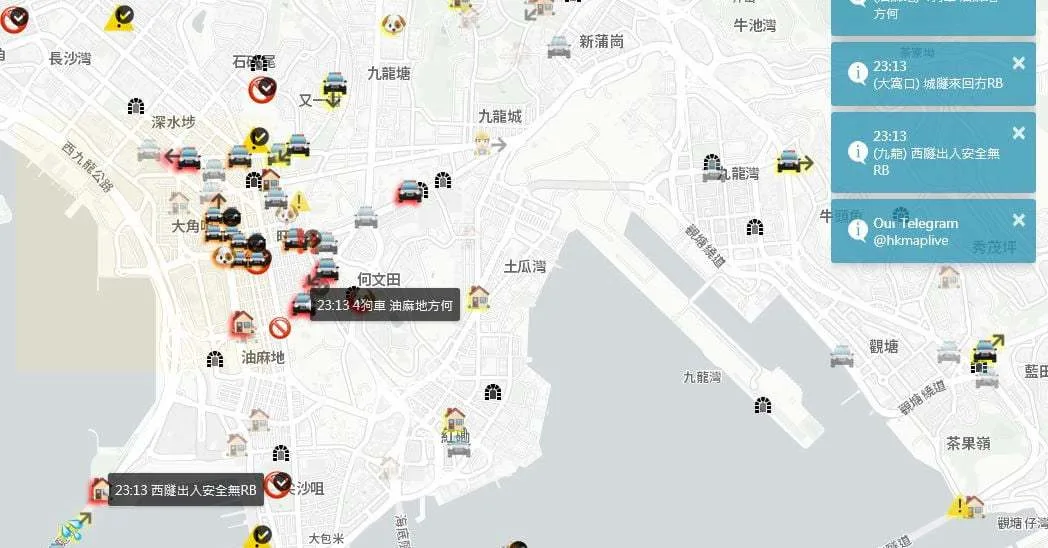
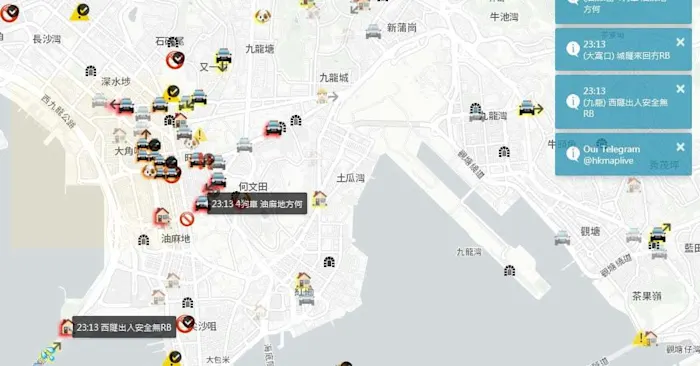
Because time spent processing information is a cost to the swarm as a whole, swarm units must take care to share only relevant information so as to avoid information overload. This is a problem that was reported regarding the Minneapolis Telegram channel devoted to relaying police scanner transmissions during the first days of the George Floyd Rebellion. Users had to sift through news about events taking place in other cities in order to find information that they could use to coordinate locally. There was also no indication of the quality of the intelligence being relayed, and the channel ended up circulating rumors about the National Guard and militias that proved untrue. The recent development of Telegram channels operating as city-specific Remote Uprising Support Teams (“RUST”) dedicated to relaying infographics and up-to-date intelligence seems to have addressed the need for exclusively intelligence-oriented communications. While the use of Telegram for informational purposes has migrated from Hong Kong to the U.S., as of now its coordinating functions has not. It is our hope that the use of burner phones and functionally oriented channels will continue to spread, so that we can experiment with the possibilities of networking crowds at demonstrations.
(iii) Omnidirectional attack. Like a bee hive attacking an intruder, the movement characteristic of a swarm is to attack from all directions in “pulses,” or short bursts that blanket the target, followed by dispersal and disengagement. Omnidirectionality requires both sufficient numbers and well-established topsight so that pods can momentarily cluster around a shared target to overwhelm it.
For example, Telegram channels were useful to Hong Kong demonstrators for collectively mapping police targets, which allowed multiple “light mages” and “fire mages” to optically disable and kinetically attack targets in a coordinated way from all sides. Convergence pulses and subsequent dispersals had to be speedy to avoid being tracked by other police units.

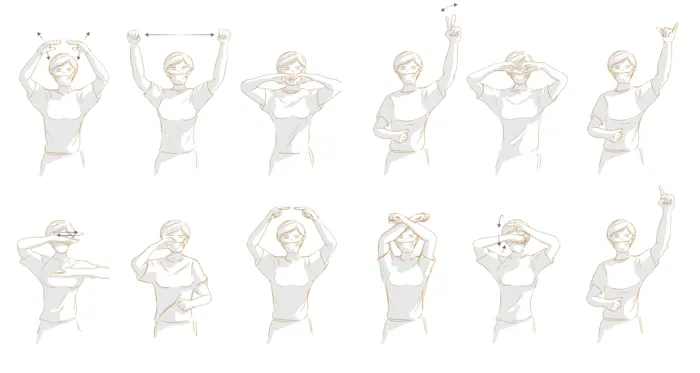
Here it may be useful to introduce Arquilla and Ronfeldt’s third variation on swarming in addition to hives and packs, namely, “mobs” composed of individuals or small groups acting opportunistically in large enough numbers to create an overall mass effect. Looting often emerges in this way, as the potential residing in the crowd’s numerical size and speed frees up its members to take individual initiative. These first acts of breaking and entering cross a threshold that opens new possibilities, but it only the spread or repetition of this first act throughout the crowd that transforms it into a mob of “looters.” Even if some members remain cautious and stand aside, they continue to effectively preserve the power of the crowd by serving as a protective barrier against those who would intervene.
Distinguishing Swarm Warfare From Other Types of Warfare
To help illustrate swarm warfare, Arquilla and Ronfeldt distinguish it from three other types of combat seen throughout human history. We relay these here not only to further clarify swarming, but to suggest that insurgents should not be orthodox about their fighting methods and should find the right mix that suits their situation.
The first of these is the chaotic melee, “a chaotic, undirected clash of arms at close quarters.” This is often seen in disorganized clashes with the police, particularly when the latter rely on truncheons or batons. Melees tend to favor those with superior numbers and weaponry, which is why Arquilla and Ronfeldt argue that “massing” (or mass warfare) most likely developed as an evolution of the melee. Mass warfare privileges the number of fighters and institutes command hierarchies. While this involves a small number of advances—breaking an army up into sections and lines as well as the development of semaphores such as hand signals, flags, and calls to communicate directives across the distance of the battlefield, all of which were developed explicitly in Hong Kong in 2019—both the chaotic melee and mass warfare primarily rely on the “brute force” of numbers to win. With certain technical and communicational advances, however, the warfare of “nimble maneuvering” arose to allow smaller armies to overcome their quantitative disadvantages.
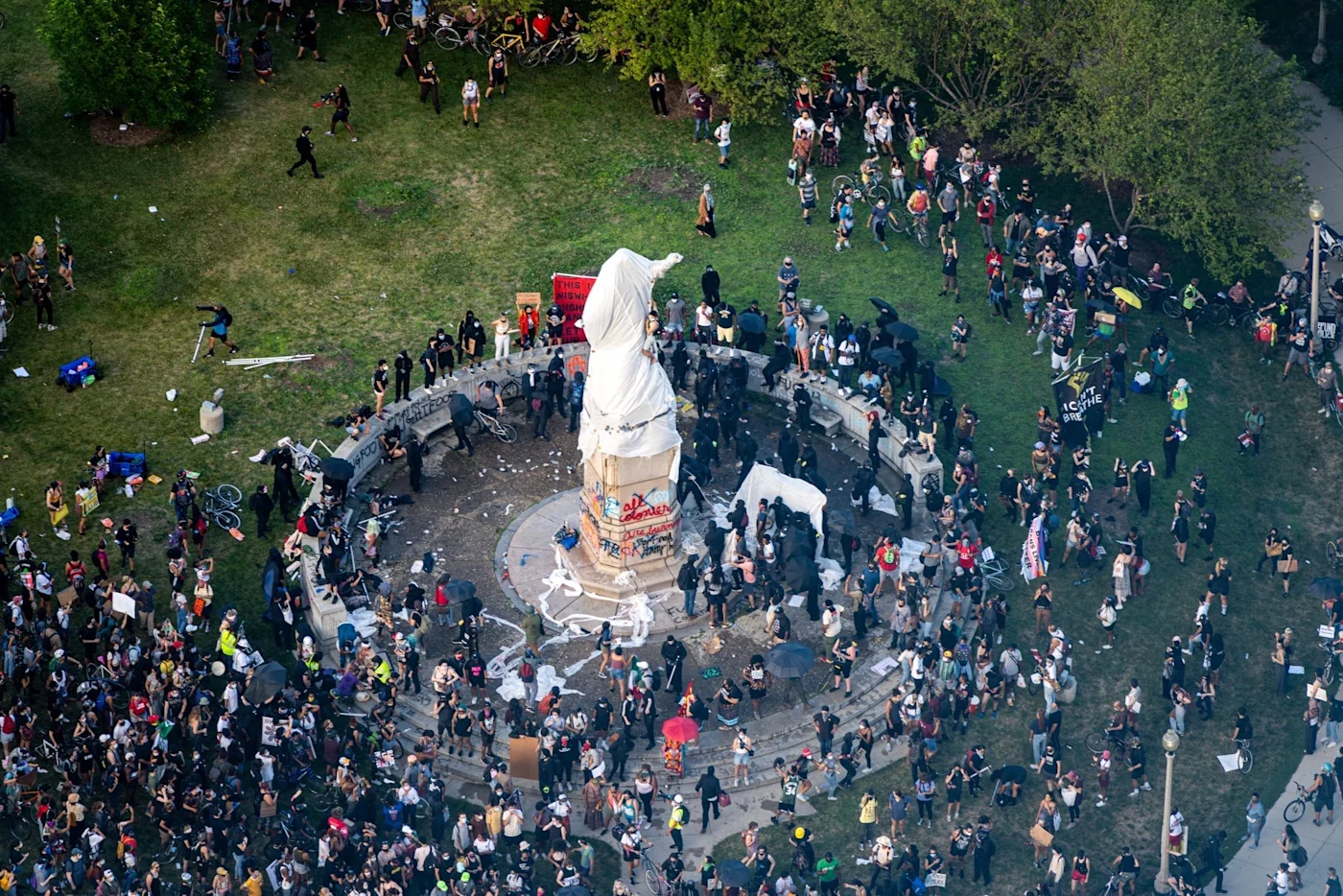
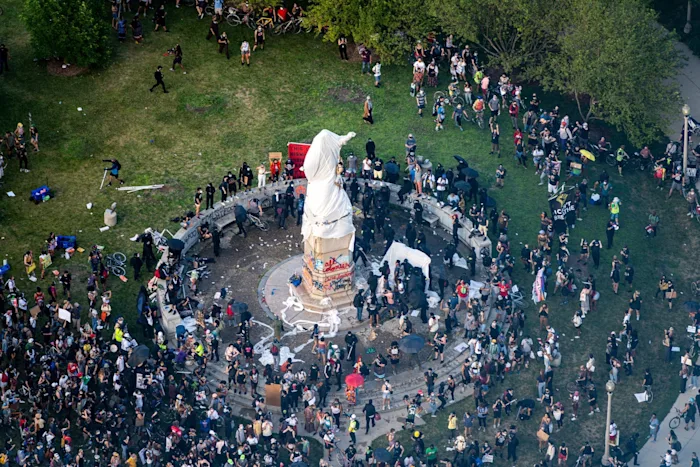
Nimble maneuvering primarily involves fighting by creating disorganization in the enemy’s ranks. Sometimes this will involve exposing weak points or isolated targets that can be attacked in detail, or the use of feints to draw the enemy to a position that will over-stretch its capacity for coordination. A recent example of this comes from the battle for the Columbus Statue in Chicago on July 17th, 2020. There, riot police attempted to retake the hill of the statue by first using immense amounts of pepper spray and baton blows to beat back demonstrators. The scattered and weakened crowd partially retreated at certain points, which enticed a portion of the police line to go on the offensive. Advancing police had to break off from their line into smaller units of a half-dozen or so. However, in at least one instance, one of these break-off units strayed too far and were lured in by a small number of demonstrators squaring off against them. The latter linked arms to form a small line against the police. The police unit violently responded with baton bludgeon until more demonstrators quickly joined, some linking arms, some simply running up to attack the officers with projectiles and kicks. Soon, the small unit of riot police found themselves not only too far away from their line to receive support, but surrounded by a snaking line of demonstrators, who harassed and assaulted this unit until they were forced to flee. In what turned out to be something akin to a reversal of pack swarming, this unit had overestimated itself in breaking off from its line, enticed as it was by what initially appeared to be an “easy target.”
The Limit of Swarm Warfare in Advanced State Militaries
It is crucial to point out that, as Arquilla and Ronfeldt argue, state militaries using swarm tactics encounter the same limits as those using mass warfare or nimble maneuvering, namely, partisan guerillas. A guerrilla force that fights on its own territory amongst a supportive population will always have an advantage against state militaries. Such a force knows the terrain and can disappear into the general population, who will also provide the guerrillas with solutions to many of its logistical needs. In the last forty years, nation states have been largely averse to genocidal techniques of total destruction such as carpet-bombing campaigns and nuclear warfare, and have only employed these means at great costs to their legitimacy amongst their own citizens.
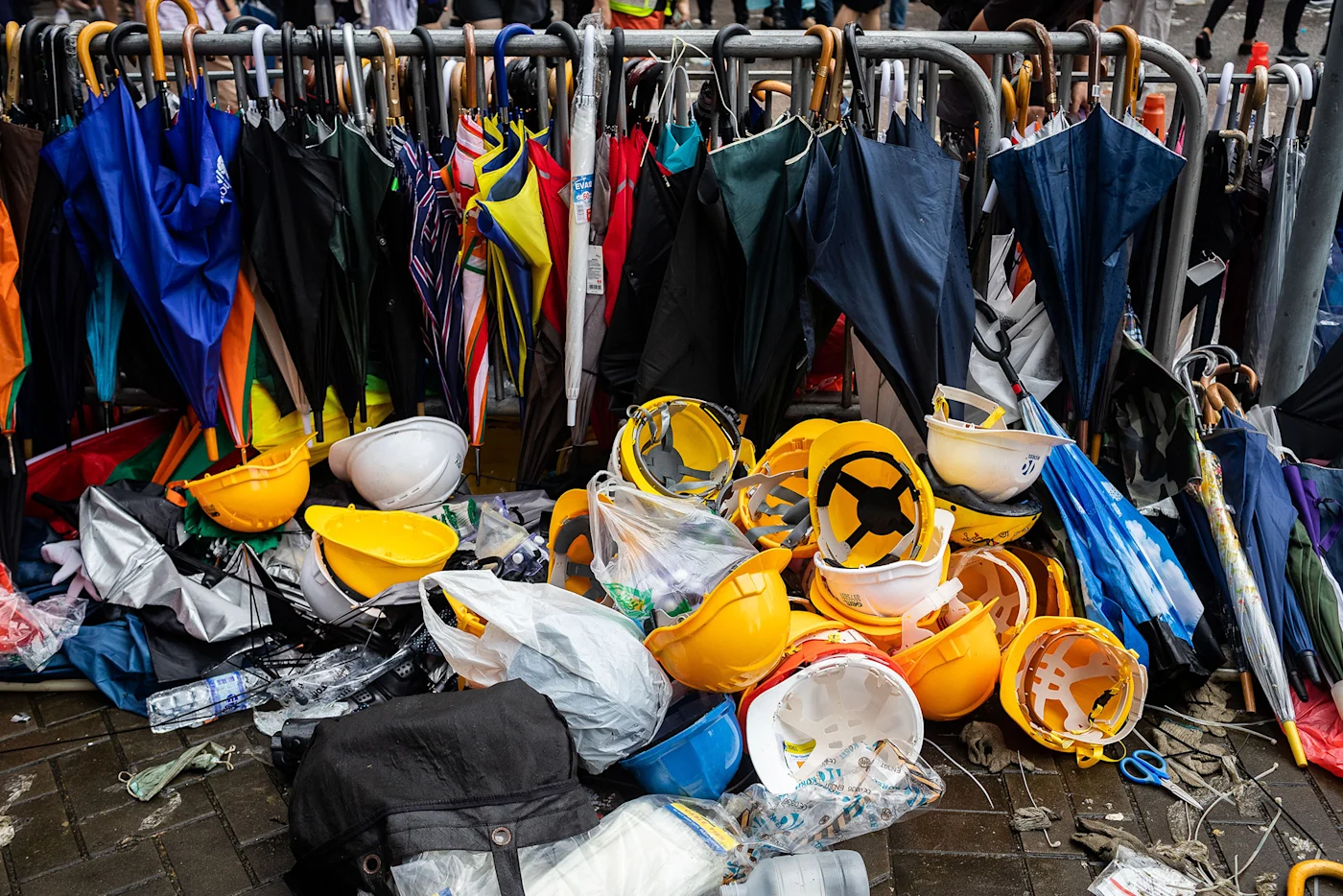
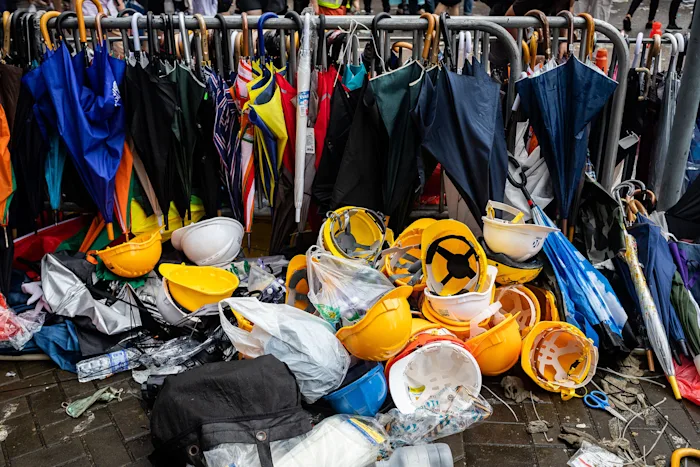
Furthermore, as the development of warfare has favored non-linear forms focused on indefinite pacification rather than total destruction, contemporary nation states are unlikely to surpass the limit posed by guerrilla warfare anytime soon. Revolutionaries should bear this in mind as our conflicts with the state and far-right forces escalate. In cities and suburbs, we will need neighborhoods into which we can disappear, and partisan-minded residents willing to provide mutual aid to combattants. In Hong Kong, for instance, some people stashed changes of clothes for frontliners and organized caravans to pick up demonstrators from “hot” parts of the city. In one instance, a Telegram channel of anonymous users crowd-sourced an escape route and a pick-up crew for a frontliner through the subterranean tunnel systems beneath Polytechnic University. As one reporter put it, “it was an operation of someones.” During the first days of the George Floyd Rebellion in Minneapolis, residents placed boxes of bottled water and sandwiches at the edge of their lawns, a practice that has since spread to dozens of other cities. These small gestures of care and support will need to grow in number and become ever more partisan as the struggle advances.
Notes
1. For those interested in a detailed discussion of swarm warfare, it is recommended to read Swarming and the Future of Conflict either as a whole or by perusing the section headings to identify key parts that are relevant to one’s needs (many are of interest only to state military officials). The book is under 100 pages and neatly organized, making it easy to come up with selections tailored to your group’s needs. One can download the e-book directly from RAND for free: https://www.rand.org/pubs/documented_briefings/DB311.html↰
2. Two examples that involve what Arquilla and Ronfeldt call “cyber swarming” are the scandal of Russian meddling in the U.S. elections of 2016 and the “bot-circulated” or amplified false rumors following riots and looting throughout the George Floyd Rebellion.↰
3. “Cyber swarming,” or the swarm activity of internet users on social media, is too broad a topic to cover here. Arquilla and Ronfeldt were also early theorists of this phenomenon with their book, Networks and Netwars: The Future of Terror, Crime, and Militancy. Alex Goldenberg and Joel Finkelstein have recently authored a report on the cyber swarming of the Boogaloo movement over the course of the George Floyd Rebellion titled Cyber Swarming, Memetic Warfare and Viral Insurgency: How Domestic Militants Organize on Memes to Incite Violent Insurrection and Terror Against Government and Law Enforcement. In it, they argue that the Boogaloo movement has grown and spread as a literal virus, using viral strategies to conceal their existence, compromise the immune structures of civil society, and foment the conditions for swarm attacks in relation to political crises. ↰
4. In Hinterland: America’s New Landscape of Class and Conflict, Phil Neel describes the role of “hooligans” and “ultras” in aiding the Egyptian Revolution of 2011. See pp. 153–156. A printable copy of two key chapters is here. ↰
5. See “Summer in Smoke” by The Vitalist International. http://chuangcn.org/2019/12/summer-in-smoke/↰